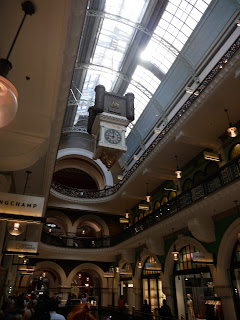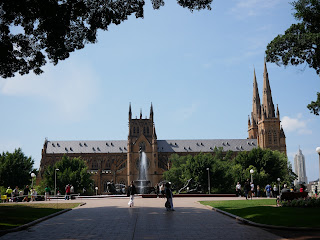I booked a three-hour free walking tour with I'm Free, the same group who showed us around Melbourne, and The Rocks section of Sydney. It was a comedy of errors to find the start of the tour when Google Maps tried to send me through a solid wall in the back of a grocery store -- yes, that is where I was supposed to be, but there was no door in sight. When I arrived I saw Owen in his trademark lime green shirt leading a group from St. Andrews, Sydney's oldest cathedral, down George Street, the longest street in the city.
 |
| Islay, the Skye Terrier |
I missed the beginning of the tour, but followed them to the Queen Victoria Building, the QVB to the locals, Sydney's first marketplace. Outside the Romanesque revival building is a bronze statue of Queen Victoria herself that used to be located in Dublin. A small statue of the Skye Terrier Islay, her favorite dog, was added to hide a heating vent. The dog is based on a drawing by Queen Victoria. This statue encourages donations to the Royal Institute for Deaf and Blind Children. In 1998 actor John Laws was recorded pretending to be Islay asking for donations, and barking at the end. The guide made it talk for us.
In 1898 construction was begun. By the 1960s there was talk of knocking it down and turning the space into a parking lot. Amazing how often I hear similar stories all over the world. Fortunately someone stepped in and it was saved and restored to the glorious shape we see today. At one point, Queen Elizabeth II handed over an envelope to be opened in 2085.
The QVB is known for international shopping, the Strand it known for upscale Australian shops. Both are very elegant with glass ceilings that evoke a feeling of an open air market. The Strand was not our our tour, but I did walk past it on another day.We continued to Hyde Park, named after the famous one in London. Owen filled us with some history dating back to the Aboriginal tribes that were here for 65,000 years before James Cook "discovered" the land in 1770 and claimed it for Britain. Eighteen years later, in 1788, the first 1,000 convicts came to Australia on 11 ships. London was overcrowded, and they lost the American Revolution so they could no longer send their prisoners there. The prisoners were slave labor. It solved the problem of what to do with the more undesirables. The problem was, none of the prisoners were farmers or had skills suitable for building a new country. Until 1830, at least 60% of the population were convicts. In 1847 the last ship of convicts was sent over. In 1851 they had a gold rush (two years after the one in California, but much bigger). The British continued to move further and further into the land inhabited by the Indigenous people. By 1900, 83% of the Aboriginal people had died. In 1869, indigenous children were taken to live with white families, resulting in the Stolen Generation. A practice that continued for 100 years. There was a vote on October 14, 2023 to restore some indigenous rights, but it failed to receive a YES for at least 50% of the votes.
After the history lesson, we walked to St. Mary's Catholic Cathedral in the center of Hyde Park. It took 130 years to complete this building. The original one burned down. I went inside later in the trip.
The Archibald Fountain was created with money stipulated in JF Archibald's will for an electric fountain. He died in 1919. Designed by a French architect, it took a few years to create a plan and build the statue that commemorates the relationship between Australia and France that was forged in World War I. It is now is a beloved meeting place in the park.
We passed a statue of Lachlan Macquarie, the fifth governor of New South Wales. There are a lot of things named after him and his wife, Elizabeth. History considers him to be both a wonderful and a terrible ruler. That could probably be said of a lot of rulers.
Across the street is St. James Anglican Church built in 1834. At the time, it was the tallest building in Sydney. The Sky Tower behind it is 309 meters tall (just over 1,000 feet).
Next door is the Rum Hospital that was built through a tax on rum in order to provide medical treatments for those living in Sydney in the early 19th century. Prior to that, a tent served as the local hospital.
At this point I felt Owen was racing ahead so he could finish before Leo, who was taking a more leisurely pace to tell the same stories. Leo also spoke a little slower, making it easier for me to take notes and pictures.
Back to Macquarie's statue. The good he did included building roads and bridges using convict labor. Inside the southern wing of the Rum Hospital is a more realistic statue of Macquarie.
Inside the Rum Hospital building is the first mint built outside of Britain. It also houses the Art Gallery of New South Wales of Modern Art, which is free, but was being renovated during my visit. Today the Sydney Eye Hospital is in one of the wings. The north wing houses the NSW Parliament House.We passed the Il Porcellino statue, which I noticed the night before.
Across the street, under scaffolding, in Martin Place is the reserve bank. Australia was the first country in the world to distribute plastic (instead of paper) currency. The pro: it does not disintegrate in the wash. The con: we couldn't figure out how to flatten it to insert a bill into a machine.
In front of the General Post Office, known locally as the GPO, is a statue dedicated to World War II soldiers. While the GPO does have a small shop to buy stamps, it is mostly filled with stores and restaurants. People just don't mail items like they did in the past.
We returned to George Street, and took it to Andrew Place where we saw dozens of bird cages dangling from wires, and heard a variety of bird calls. It is called "Forgotten Songs" because the calls are of birds who used to inhabit this area before all the building took place. Leo said this is Sydney's attempt to create cool street art similar to Melbourne's art culture.
About this point someone asks "how long is this tour?" to which we are told three hours. Those of us of a certain age who grew up in the United States immediately start humming the "Gilligan's Island" theme song. Most of the group could not appreciate this cultural reference. I felt both old and out of place.
Leo tantalized us with stories of secret bars in Sydney. Unfortunately, too secret to share with us the exact locations or give us clues to find them on our own. I suppose that does defeat the purpose. A google search found some, but it wasn't something I felt like doing on my own.
By now even I was ready for a break. I took out the peanut butter sandwich I made in the hotel room for this purpose and found a spot to sit. I ended up having a discussion with Leo about how awful the gun laws are in the United States. He was the first person on the trip to tell me how wonderful my country is -- the land of opportunity for an entrepreneur and I burst his bubble. I felt bad about that.
Leo took us inside the Customs House to see a "helicopter view" of a diorama of Sydney. I tried to take pictures of it, but could not capture its size or scale.
We crossed a street filled with trams and buses, cars and people to the Circular Quay where we could see the Sydney Opera House, and where to catch catamarans to Manly Beach. Then we started overlapping information with my the I'm Free tour of The Rocks I took two days earlier. Out of habit, I continued to write notes, but I see they repeat much of what I have already blogged about until he talked about the building of the Sydney Harbour Bridge.
In 1815 Francis Greenway wanted the bridge to be built, in Sydney's early days. The 1.3 kilometer bridge (less than a mile) was built in 1923-32. Sixteen workers died during construction. It is amazing it was not more people since it was built without safety harnesses. Five hundred homes were demolished to make space to build the bridge. It's nickname is "the ugly coat hanger."
He succinctly repeated much of what I paid to learn about the Opera House the day before, but did add that several times each evening there are projections on the side of the opera house. I went back to see them.
In 2003 someone climbed to the top of the "sails," as the opera house is called, to paint the words NO WAR in red paint. It cost $115,000 AUS ($100,000 USD) to clean off. The perpetrators were fined to pay for the cost of removal. They in turn made souvenir models of the opera house with the words NO WAR on them to pay the fine.
He ended with the cheery note that 103 people died during the plague, then asked for us to pay what we thought the tour was worth.
This seems like a good breaking point. I'll pick up with how I spent the rest of the day in the next post.















No comments:
Post a Comment